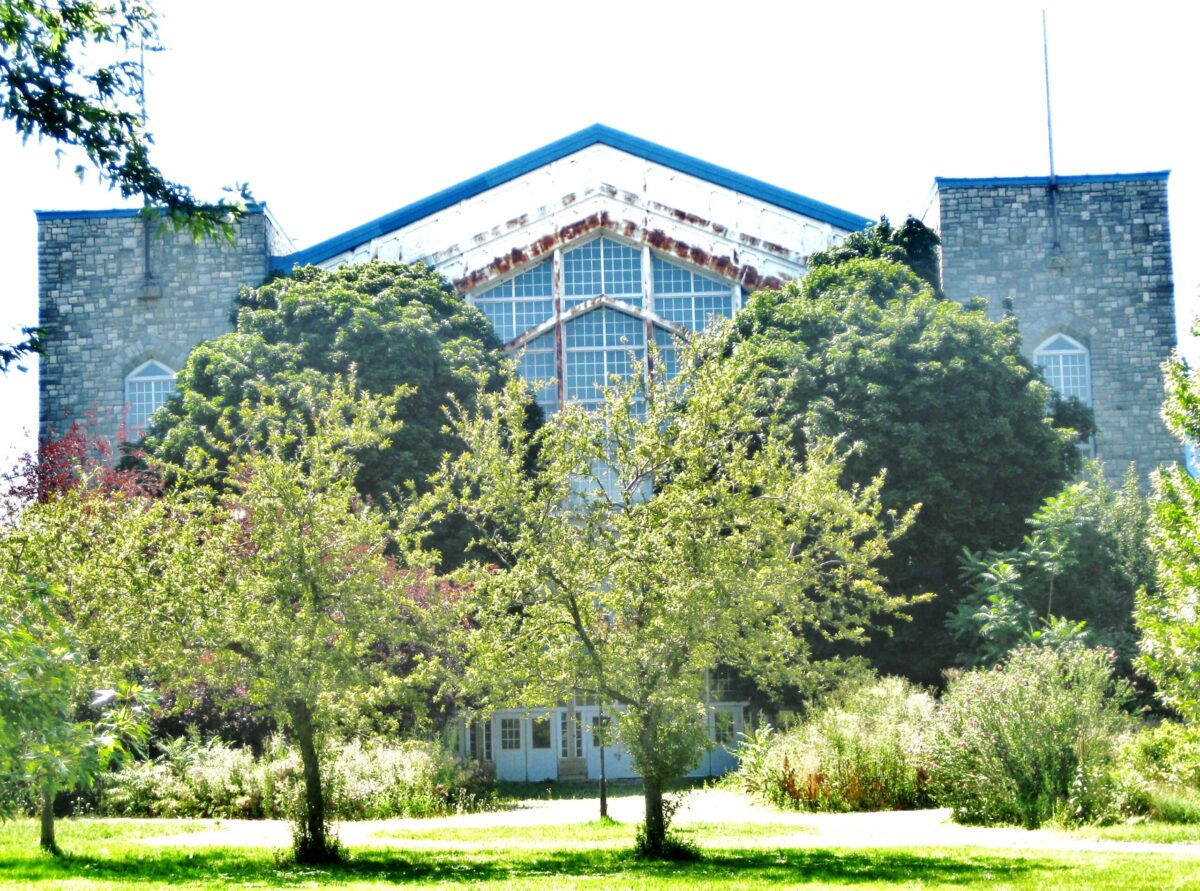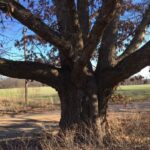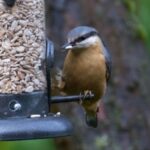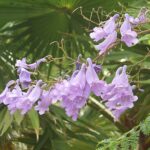
Without a doubt, this tree should never have been planted where it is.
This is the biggest of three honey locusts planted around our house. While I can’t separate this particular honey locust from the other trees planted between the two houses in earlier photos of our property, you can just decipher the slender trunk of the honey locust planted in our front yard (in what we think might be the 70s, judging from the car).

A member of the pea (!) family (Fabaceae), honey locusts are fast-growing trees. The one on the drive may have gotten a boost in 2007 and 2008 from having its roots cut along the entire west side of my neighbors’ house when they had a foundation added to their house. A tree service consultant told me at the time that such cutting shouldn’t hurt the tree, and in fact, may make the tree grow “like a weed.”
Maybe it has. But some developments that I’ve noticed over the last two years–involving its trunks, branches, and roots–have worried me.
The Bump
A bump just below the first fork (aka crotch, or main union) of the tree had appeared and seems to be increasing in size. What is causing it? Is it making the main union weaker?

A little bit of research indicates that the bump is a burl. Most burls result from some sort of injury to the tree or infection by viruses, fungi, bacteria or insects. Lovely.
While burls are prized by woodworkers for their unusual woodgrain pattern, I’d prefer not to have one growing off the trunk of a tree for which I’m responsible.
Deepening Divisions
The burl isn’t the only thing going on with the trunk.
Instead of possessing one solid round-in-diameter trunk, like the other two honey locusts have, this one seems to be a composite of four pole-like legs with what appears to be deepening divisions. Imagine four very large asparagus stalks rubberbanded together, covered in bark, and melded together in the middle. Squirrels have taken to storing their treasures in the crannies between the segments. Does this unusual structure make the tree stronger or weaker?
Chipmunk Bunker
Our driveway has been cracked for a long time, maybe since before we moved in. It’s become clear from their location that the cracks are caused by the apparently flourishing roots of the honey locust. This past year, a crack became an open crevice. Judging from activity in the fall, a very cozy chipmunk is hibernating there now.
Icy Fingers
Despite having had deadwood trimmed and the crown raised higher above our roof a few years ago, when ice coated the branches and twigs during storms this winter, I could see–and my neighbor Kate could hear–the tree’s fingers dragging along her roof.
Seeking Advice
Our former tree service consultant suggested we put four metal bolts through the trunk to hold the segments together and install two cables in the tree’s crown. However, this was not going to be cheap or guaranteed. Maybe I should spend just a little bit more and have the tree cut down instead?
When I asked for a second opinion of a highly recommended arborist at a local nursery, she asked for photographs. Basing her opinion on the photographs I e-mailed her, she basically responded, “Bad spot for a not-good specimen of the species. Remove it.”
This seemed harsh. If the tree did not pose a danger to my neighbors’ or my house, who was I to remove it?
This arborist, not knowing that she was my second opinion, offered the contact information for another arborist to provide another opinion. He came out, saw the tree, and said that while his opinion was that the tree never should have been planted where it was, there was no reason why it would not stand.
On the other hand, he continued, there is never a guarantee. Some of the strongest-looking trees fall. Oh, great.
Complicating Factors
Did I mention that both of the entrances to our house are off of our driveway, directly across from the tree? And, that a honey locust, while providing beautiful dappled shade with its ferny “twice compound” leaves composed of small leaflets. . .

. . . loses those small leaflets when they are green, yellow, and brown, all year long. I am forever sweeping and picking up small leaflets tracked in on the soles of every single person who enters our home.

This honey locust has probably been growing in this spot for about 50 years. Trees of this non-native species generally live 100 – 125 years. And, now the decision whether it lived or died was up to me. My husband, wise man that he is, knowing how I felt about trees, refused to offer an opinion.
What I Wish
I fervently wish that the tree had never been planted where it was. Or that one of the two owners of the property before I moved in had removed the tree. But it was, and they hadn’t.
I would be excited for the opportunity to have a new smooth driveway poured come spring.
I would be so very happy to be able to stop sweeping–or feel like I should be sweeping–my seriously cracked drive, our two entrance stoops, every room in my house.
I would love for the small leaflets–along with the increasingly big worry that keeps me awake these windy nights–to simply vanish from my life.
But . . .
But when this honey locust is in leaf, the tree rises above our houses in a fountain of green that can be seen upon the downhill street approach across from our houses or from an around-the-block stroll.
It is a part of the neighborhood’s canopy, a canopy which has already been severely diminished in the last 5 years by developers’ greed.
The honey locust’s trunk with a circumference of 6’8′ also creates a division between my neighbor’s windows and the windows of our living space. We are very fortunate to have good neighbors on both sides of us, but with respect to the east, our houses would seem much closer without the honey locust between them.
What to Do?
Until this week, I thought the best thing someone could have told me was that the inside of the tree was rotten and that a wind like those we’ve had in the past week could blow it over. Then both my worry and the mess of the leaflets could have been removed without evoking any guilt in me about removing a mature tree. But then my neighbor suggested I call Kevin Bingham of Singing Tree, who had taken care of her mom Sue’s trees.
Singing Tree
Singing Tree also trims the trees inside the Belle Isle Conservatory and outside of Detroit’s Dorothy H. Turkel House, designed by Frank Lloyd Wright in 1956.
Kevin’s partner Emily Brent came out to have a look at the honey locust. She suggested trimming the tree’s crown up 5 – 10″ feet above my neighbor’s roof and dealing with the water drainage problem between our houses as the way to stop the tree’s roots from their interest in cracking my neighbors’ foundation.
From the ground, she was not worried about the burl, the divided trunk, or what the roots were up to. She suggested their crew leader, Evan, could do an aerial inspection and before either trimming or removal commenced, we’d have a conversation. I made an appointment for Monday morning at 9:00 a.m..
Monday Morning 8:45 A.M.




Evan preparing to climb 
Evan up in the tree via rope 
Singing Tree’s spider lift 
Dean going up in the bucket 
Dean joining Evan
In the treetop 
Positioning themselves 
Evan trimming southeast 
Dean trimming northwest 
The view from the backyard

A Reprieve for the Tree
The honey locust passed inspection. Emily, Kevin, Evan, and Dean all agreed that they’d not have planted the tree where it is, but that they would not remove if it were in such a location on a piece of property belonging to them.

Another Decision
Given the positive experience I’ve had with both partners and their crew, I’ve decided Singing Tree will be monitoring the honey locust along with the rest of the trees on my property in the years to come.

And the Winds of the Last Week?
At night, I listen to the wind in the trees outside my window. Then I drift off to sleep, with no worry. And, no guilt.









Now that is what you call “the process of making a decision.” And with a happy ending. Well done.
Thanks! (And thanks for being the “wise man” that you are :))
What amazing photos! That’s a project in itself!
Thanks, Susan! Yes. It was a very cold day, and the Singing Tree crew was here for 3 hours, during which I shot over 75 photos. So, yes, a project, but a fun one!